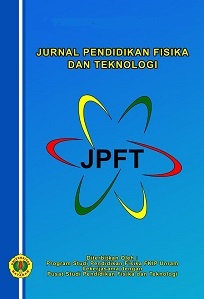The Effect of Project Based Learning Integrated STEM to Increase Science Process Skill
DOI:
10.29303/jpft.v8i2.4439Published:
2022-12-29Issue:
Vol. 8 No. 2 (2022): July-DecemberKeywords:
Project Based Learning, STEM, Science Process SkillArticles
Downloads
How to Cite
Downloads
Metrics
Abstract
This research aims to determine the effect of project-based learning integrated with the STEM method on the greenhouse effect and global warming on science process skills of class XI of the MIPA program in Senior High School in 9 Jakarta. This research is experimental research with two groups. Class control using discovery learning and class experiment using PJBL integrated with STEM. The instrument is a multiple-choice test with as many as 20 questions that use science process skills indicators. Analysis of this research data using the independent sample t-test was used to see the effect of the learning model on the science process skills, and the results obtained showed a significant effect. From the results of the analysis data, there is an effect of PjBL learning integrated STEM method to increase science process skills of students of class XI. Applying project-based learning integrated with STEM dramatically improves students' abilities, especially in observing, applying and conducting experiments. For the questionnaire students' responses to the implementation of the learning model, more than 80% of students were becoming more motivated in learning, more help understanding the subject matter, and could improve their problem-solving abilities.
References
Afriana, J., dan Fitriani, A. (2016). “Penerapan Project Based Learning Terintegrasi STEM Untuk Meningkatkan Literasi Sains Dan Kreativitas Siswa Ditinjau Dari Gender”. Jurnal Inovasi Pendidikan IPA, 2(2): 202–212
Agustina, D., Kaniawati, I., Rahma, I. (2017). Penerapan Pembelajaran Berbasis STEM (Science, Technology, Engineering and Mathematics) Untuk Meningkatkan Kemampuan Control of Variable Siswa SMP Pada Materi Hukum Pascal. Prosiding Seminar Nasional Fisika SNF. http://doi.org/10.21009/03.SNF2017.01.EER.06 :35-40
Becker, K. H., & Park, K. (2011). Integrative Approaches among Science, Technology, Engineering, and Mathematics (STEM) Subjects on Students Learning: A Meta-Analysis. Journal of STEM Education, 12(5 & 6), 23–37.
Brown, R., Brown, J., Reardon, K., and Merril, C. (2011). Understanding STEM : Current Perception. Technology and Engineering Teacher, 70(6), 5-9.
Kemendikbud. (2013). Pengembangan kurikulum 2013. Paparan Mendikbud dalam Sosialisasi Kurikulum. Jakarta: Kemendikbud
Lutfi, Ismail, Aziz, A.A. (2018). Pengaruh Project Based Learning Terintegrasi STEM Terhadap Literasi Sains, Kreativitas dan Hasil Belajar Peserta Didik. Prosiding Seminar Nasional Biologi dan Pembelajarannya: 189-194
Hake, R. R. (1998). Interactive-engagement versus traditional methods: A six-thousand-student survey of mechanics test data for introductory physics courses. American Journal of Physics, 66(1), 64–74. http://doi.org/10.1119/1.18809.
Kurniasari, Riana Dewi. (2017). Penerapan Model Pembelajaran Project Based Learning Untuk Meningkatkan Hasil Belajar Fisika dan Keterampilan Proses Sains Peserta Didik Kelas X SMA N 1 Banguntapan. Yogyakarta
Laboy-Rush, D. (2010). Integrated STEM education through project-based learning. www.learning.com/stem/whitepaper/integrated-STEM-through-Project-based-Learning
Lazim, M. (2013). Penerapan Pendekatan Saintifik dalam Pembelajaran Kurikulum 2013 Pengembangan dan Implementasi Kurikulum 2013. Bandung: Remaja.
NRC. (2012). A Framework for K-12 Education : Practice, Crosscutting Concepts, and Core Ideas. The National Academics of Science. Washington DC.
Sugiyono. (2013). Metode penelitian pendidikan (pendekatan kuantitatif, kulaitatif, dan R & D). Bandung : Alfabeta
Suwarna, I.R., Asturi,P., Endah ,N.E. (2015) “Ballon Powered Car Sebagai Media Pembelajaran IPA Berbasis STEM (Science, Technology, Engineering and Mathematics). Prosiding Simposium nasional Inovasi dan Pembelajaran Sains.
Wati, W., Novianti. (2016). Pengembangan Rubrik Asesmen Keterampilan Proses Sains Pada Pembelajaran IPA SMP. Jurnal Pendidikan Fisika Al-BuRuNi 05(1) : 131-140.
Author Biographies
Septina Severina Lumbantobing, Universitas Kristen Indonesia
Faradiba Faradiba, Universitas Kristen Indonesia, Jakarta, Indonesia
Manogari Sianturi, Universitas Kristen Indonesia, Jakarta, Indonesia
Taat Guswantoro, Universitas Kristen Indonesia, Jakarta, Indonesia
License
Copyright (c) 2022 Septina Severina Lumbantobing, Faradiba Faradiba, Diaz Jubairy Prabowo, Manogari Sianturi, Taat Guswantoro

This work is licensed under a Creative Commons Attribution-ShareAlike 4.0 International License.
Authors who publish with Jurnal Pendidikan Fisika dan Teknologi (JPFT) agree to the following terms:
- Authors retain copyright and grant the journal right of first publication with the work simultaneously licensed under a Creative Commons Attribution License 4.0 International License (CC-BY-SA License). This license allows authors to use all articles, data sets, graphics, and appendices in data mining applications, search engines, web sites, blogs, and other platforms by providing an appropriate reference. The journal allows the author(s) to hold the copyright without restrictions and will retain publishing rights without restrictions.
- Authors are able to enter into separate, additional contractual arrangements for the non-exclusive distribution of the journal's published version of the work (e.g., post it to an institutional repository or publish it in a book), with an acknowledgement of its initial publication in Jurnal Pendidikan Fisika dan Teknologi (JPFT).
- Authors are permitted and encouraged to post their work online (e.g., in institutional repositories or on their website) prior to and during the submission process, as it can lead to productive exchanges, as well as earlier and greater citation of published work (See The Effect of Open Access).











